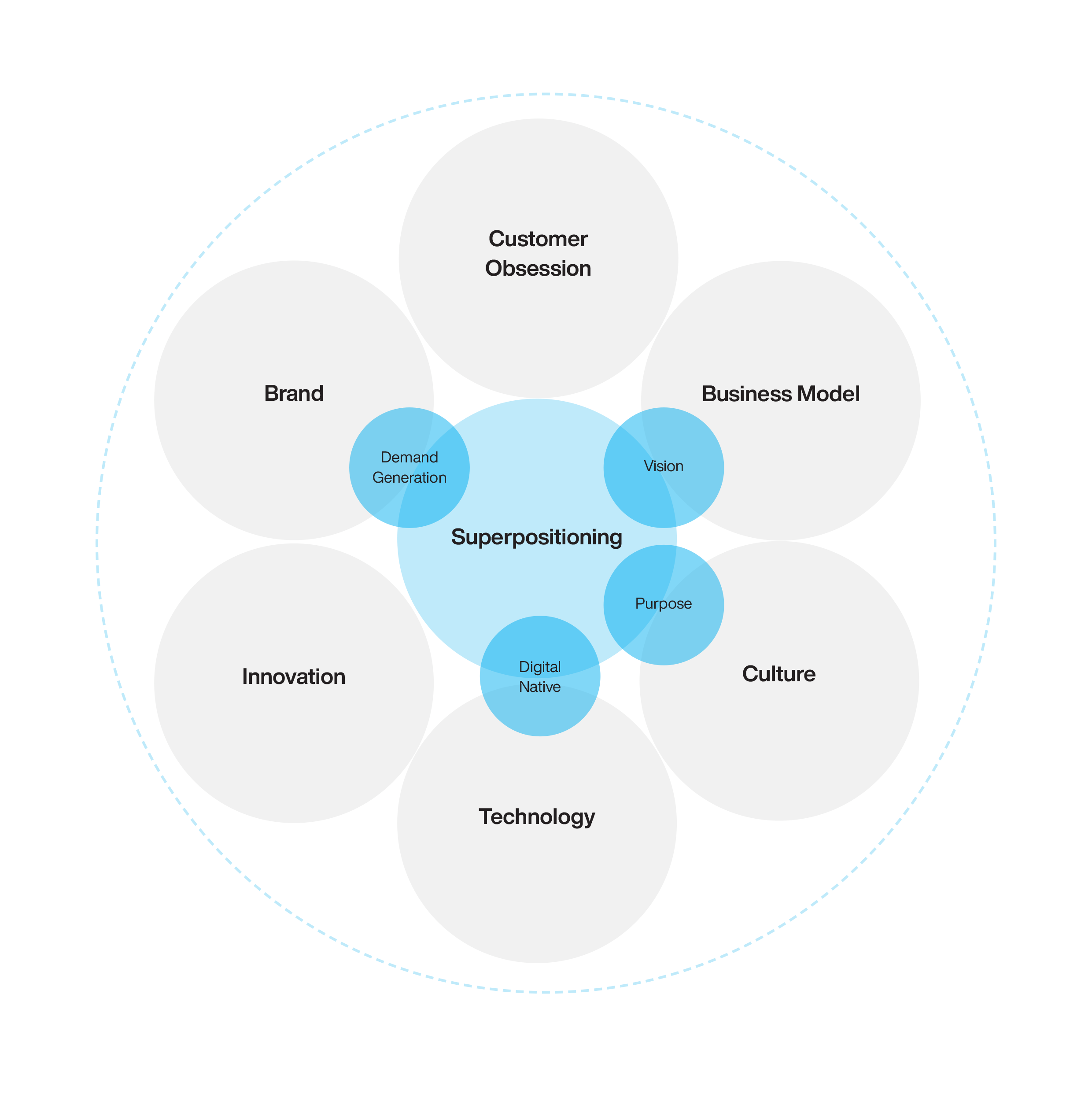X Method
Superpositioning
-
Embracing Superpositioning for Innovative and Resilient Business Success
-
Discover how the concept of superpositioning, borrowed from the realm of quantum physics, is inspiring organisations to create innovative, adaptive, and resilient business strategies.
The rapidly evolving business landscape requires organisations to think and act in new ways to maintain a competitive edge. One fascinating concept gaining traction in the world of business strategy is superpositioning, a principle borrowed from the domain of quantum physics. This intriguing idea is inspiring businesses to develop innovative strategies that enable them to adapt to shifting market conditions and thrive in an increasingly complex world by incorporating future state focus, category creation, and systems thinking. In this article, we’ll explore the concept of superpositioning and examine how it can revolutionise the way organisations approach strategic planning.
Superpositioning: A Quantum Leap in Business Thinking
In quantum physics, superposition refers to the idea that particles can exist in multiple states simultaneously until they are measured or observed, at which point they collapse into a single state. Although this concept may seem abstract and far removed from the world of business, its underlying principles can be applied to strategic planning and decision-making, offering organisations a fresh perspective on how to navigate uncertainty and complexity.
By embracing superpositioning, businesses can develop strategies that allow them to exist in multiple states or scenarios simultaneously. This approach enables organisations to remain agile and responsive, adjusting their strategies as new information emerges and market conditions change. In essence, superpositioning provides a framework for organisations to adapt and thrive in a constantly shifting business environment.
-

Superpositioning©
Superpositioning
-
Incorporating Future State Focus, Category Creation, and Systems Thinking
To effectively implement superpositioning into their strategic planning, organisations should consider incorporating the following concepts:
- Future State Focus: Organisations should develop a clear vision of their desired future state and use it as a guiding principle for their strategic planning. By focusing on the future, businesses can anticipate changes in the market, identify emerging opportunities, and position themselves for long-term success.
- Category Creation: Embracing superpositioning encourages organisations to think beyond traditional industry boundaries and create entirely new categories of products or services. By doing so, businesses can differentiate themselves from competitors and capture untapped market opportunities.
- Systems Thinking: Organisations should adopt a holistic perspective that considers the interdependencies and connections between different elements of their business. Systems thinking enables businesses to identify potential synergies, optimise resources, and develop strategies that address the root causes of challenges rather than just their symptoms.
- Embrace Uncertainty: Recognise that the future is inherently uncertain and that market conditions, customer preferences, and competitive landscapes will continually evolve. Superpositioning encourages organisations to view uncertainty as an opportunity rather than a threat.
- Develop Adaptive Strategies: Create strategies that are flexible and responsive, enabling the organisation to shift its focus, resources, and efforts as new information and opportunities arise.
- Explore Multiple Scenarios: Instead of relying on a single, linear forecast, develop multiple scenarios that reflect a range of potential outcomes. This approach allows organisations to prepare for various possibilities and respond more effectively when conditions change.
- Foster a Culture of Agility: Encourage a mindset of adaptability and resilience across the organisation, empowering employees to embrace change, experiment with new ideas, and learn from their experiences.
- Leverage Data and Analytics: Utilise data and advanced analytics to continually monitor market trends, customer behaviours, and competitive dynamics, informing the organisation’s strategic decisions and enabling it to adapt its strategies as needed.
-
The Benefits of Superpositioning: Building Resilient and Adaptive Organisations

- Increased Agility: Superpositioning allows organisations to respond more effectively to changes in the market, enabling them to seize new opportunities and navigate challenges with greater confidence.
- Enhanced Resilience: By preparing for multiple scenarios and fostering a culture of adaptability, organisations can better withstand shocks and disruptions, ensuring their long-term success.
- Improved Decision-Making: Incorporating superpositioning, future state focus, category creation, and systems thinking into strategic planning enables organisations to make more informed decisions based on a broader understanding of potential outcomes and evolving market conditions.
- Greater Innovation: Embracing uncertainty and exploring multiple scenarios can spur creativity and innovation, as organisations look for novel solutions and approaches to address the challenges and opportunities they face.
- Sustainable Growth: By developing adaptive strategies and fostering resilience, organisations can achieve sustainable growth in an increasingly complex and unpredictable business environment.
- Competitive Advantage: Superpositioning enables businesses to create and maintain a competitive advantage by differentiating themselves from rivals and continuously evolving their strategies to stay ahead in the marketplace. This competitive edge acts as a moat, protecting the organisation from competitors and allowing it to maintain its market position.
- Creating a Moat: The integration of superpositioning principles in business strategy helps organisations build a moat, a metaphorical barrier that makes it difficult for competitors to challenge their market position. This moat can be formed through a combination of unique offerings, brand reputation, and the ability to adapt and innovate faster than competitors, ensuring long-term profitability and success.
-
Superpositioning: A Quantum-Inspired Approach to Business Success

Business Architects’ Superpositioning brochure cover © 2023
In conclusion, superpositioning offers a groundbreaking approach to business strategy that draws inspiration from the world of quantum physics. By embracing uncertainty, developing adaptive strategies, and incorporating future state focus, category creation, and systems thinking, organisations can navigate the complexities of the modern business landscape with greater confidence and resilience.
Superpositioning provides a powerful framework for organisations to respond effectively to the ever-changing market conditions and capitalise on emerging opportunities. By adopting this quantum-inspired approach and integrating concepts such as future state focus, category creation, and systems thinking, businesses can position themselves for long-term success and sustainable growth in an increasingly unpredictable world. The future of business strategy may indeed lie in embracing the principles of superpositioning, enabling organisations to thrive amidst uncertainty and achieve new heights of innovation and performance.